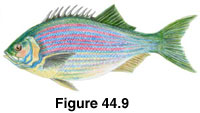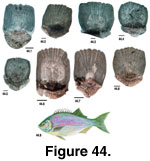 Description
Description
Embiotoca lateralis
(Striped Seaperch)
(Other common names: Blue Perch, Perch, Striped Surfperch)
Figure 44.9
 Description
DescriptionLength: 38 cm.
Mouth: small, slightly pointed upward, terminal; upper jaw close to, but not reaching anterior edge of orbit; teeth moderate and pointed; lower lip attached to lower jaw by broad frenum; upper lip often black.
Body: lateral line follows dorsal profile; caudal peduncle is compressed and deep.
Color: fifteen blue strips (curved above lateral line; horizontal below it) on dark copper or reddish background; bright blue strip on head and operculum; fins copper; juveniles are bright golden; spiny front of dorsal fin (back fin) is short; soft rear half is taller and darker.
Depth: surface to 15 m; generally shallow waters but retreats to deeper waters during late winter to early spring.
Habitat: coastal waters in kelp beds and rocky areas; generally schooling.
Season: mate in October with birthing in June and July.
Diet: small crustaceans, worms, mussels, and forage fish (e.g., herring).
Predators: not determined.
Distribution: northern Baja, California to southern Alaska.
 Scale Description
Scale DescriptionRelative Scale Size: large
Position of Scales on Body: along lateral line canal; row at anterior end of base of each dorsal fin (Hart, 1973).
Overall Shape: the A scale, being smaller, is rectangular in appearance with the lateral fields being longer than the width of the anterior/posterior axis. The larger scales are more square.
Focus and Circuli: the focus is not centralized between the four fields and is approximately one-third of the total length from the posterior margin. The focus and surrounding circuli are circular and concentric with the scale outline. The circuli are continuous from lateral to anterior fields. They are broken and discontinuous in the posterior field.
Radii: numbers are variable and not diagnostic. Present only in the anterior field. The outer edge of the anterior field is scalloped.